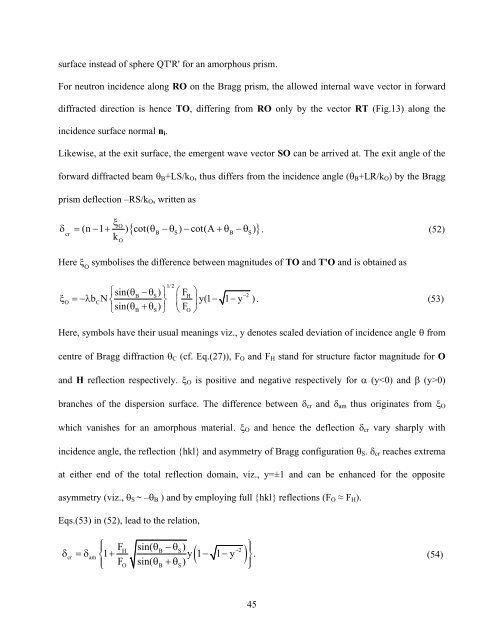PHYS01200804001 Sohrab Abbas - Homi Bhabha National Institute
PHYS01200804001 Sohrab Abbas - Homi Bhabha National Institute
PHYS01200804001 Sohrab Abbas - Homi Bhabha National Institute
Create successful ePaper yourself
Turn your PDF publications into a flip-book with our unique Google optimized e-Paper software.
surface instead of sphere QT'R' for an amorphous prism.<br />
For neutron incidence along RO on the Bragg prism, the allowed internal wave vector in forward<br />
diffracted direction is hence TO, differing from RO only by the vector RT (Fig.13) along the<br />
incidence surface normal n i .<br />
Likewise, at the exit surface, the emergent wave vector SO can be arrived at. The exit angle of the<br />
forward diffracted beam B +LS/k O , thus differs from the incidence angle ( B +LR/k O ) by the Bragg<br />
prism deflection –RS/k O , written as<br />
<br />
. (52)<br />
cr<br />
<br />
O<br />
(n 1 ) cot(<br />
B S) cot(A<br />
B S)<br />
kO<br />
Here O<br />
symbolises the difference between magnitudes of TO and T'O and is obtained as<br />
<br />
sin( ) F <br />
O<br />
<br />
<br />
1/2<br />
B S H<br />
2<br />
bCN y(1 1 y )<br />
sin( B S) FO<br />
. (53)<br />
Here, symbols have their usual meanings viz., y denotes scaled deviation of incidence angle from<br />
centre of Bragg diffraction C (cf. Eq.(27)), F O and F H stand for structure factor magnitude for O<br />
and H reflection respectively. O is positive and negative respectively for (y0)<br />
branches of the dispersion surface. The difference between cr and am thus originates from O<br />
which vanishes for an amorphous material. O and hence the deflection cr vary sharply with<br />
incidence angle, the reflection {hkl} and asymmetry of Bragg configuration S . cr reaches extrema<br />
at either end of the total reflection domain, viz., y=±1 and can be enhanced for the opposite<br />
asymmetry (viz., S ~ – B ) and by employing full {hkl} reflections (F O ≈ F H ).<br />
Eqs.(53) in (52), lead to the relation,<br />
<br />
F sin( )<br />
cr<br />
am<br />
<br />
<br />
FO sin( B S)<br />
H<br />
B S<br />
2<br />
1 y 1 1 y .<br />
<br />
<br />
<br />
<br />
<br />
(54)<br />
45
















